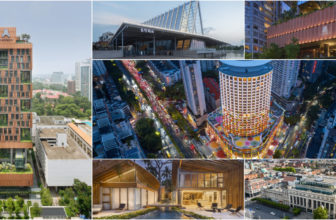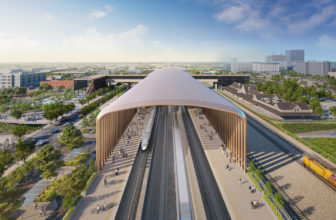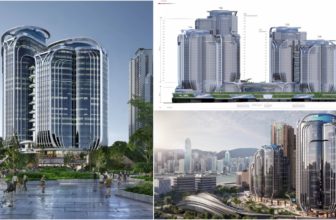Published on: Sep 19, 2023 By: Jack Andrews
What if a career could merge the excitement of discovery with the power of transformative design?
Well, Aruna A Das, an exciting young architect from India, has turned that vision into reality. She’s traversed three continents, earned degrees from elite institutions, and spearheaded projects that are reshaping city skylines. But Aruna’s story is more than just her meteoric rise to the créme of the architectural elite. It’s one of resilience, innovation, and a profound understanding of what she does not want for her life—a guiding philosophy that has shaped her every decision and led to her success.
Born in Calcutta, a city known for its historic architecture, Das’ fascination with buildings and spaces began early. Her father’s job kept the family moving across India, giving her the chance to explore the distinct urban flavors of cities like Mumbai, Pune, Chennai, and Bangalore. Each move introduced her to new textures, colors, and architectural styles, igniting a design passion that would eventually define her career.
“When I was young, my parents would take us on road trips beyond the metropolitan boundaries. These trips would inadvertently expose me to the wonderful variety of textures, colors, and designs that India offers. My mind was always on fire with ideas,” Das recalls.
Her early penchant for design was evident in how she would spend hours at a stationary store, drawing detailed floor plans on graph paper, engrossed in her world of space and experience. However, like many Indian parents, Das’ family initially had reservations about her career choice. “There is no money in architecture; it’s no job for a woman. Why don’t you become an engineer or a doctor?” her parents would say. But Das remained undeterred. She saw architecture as more than just a profession–it was her calling. So, she signed up for a Bachelor’s in Architecture at the University of Visvesvaraya College of Engineering in Bangalore.
And it turned out to be a brilliant move, especially since Bangalore was buzzing with energy and transformation during the IT boom of the early 2000s. “I lived through the city’s transition, saw it morph into a mega-city, and experienced both the benefits and drawbacks it brought,” she says.
This experience, combined with the intense hands-on training she received in architecture, really prepared her for what was ahead. During her undergraduate years, Das grew really frustrated with how slow traditional design tools were. She remembers how tedious it was to draft designs by hand, use carbon copy paper, and redo entire blueprints for tiny mistakes. “I quickly developed a distaste for the snail’s pace at which we designed and the way we represented our work,” she explains. That frustration was a fuel that really turned things around for her. It pushed her to dive into digital tools like AutoCAD, Rhino, the Adobe Suite to change the way we represent our work. She took online courses to upskill, and they made a significant difference in accelerating her creative process.
After graduating, Das started as an intern at RSP Architects in Bangalore. It didn’t take long for her to make a splash—within just three years, she was already handling major projects, including master plans for big names like Microsoft and The Prestige Group. A big highlight for her was when RSP Architects landed the Microsoft Campus project. That win not only gave the firm a major boost but also really put Das in the spotlight as an up-and-coming talent in architecture. “My mind was always on fire with ideas” But Das knew she needed to broaden her horizons and deepen her expertise. She took a calculated risk, saving up enough to take a loan and pursue a master’s degree in architecture and urban design at the Städelschule Architecture Class in Frankfurt, Germany.
“It was in Frankfurt that I was introduced to virtual reality as a medium to bring life to the design space,” Das explains. She immersed herself in advanced design techniques and was mentored by some of the world’s leading architects and theorists, including Theodore Spyropoulos, Peter Trummer, and Mark Wigley. Her master’s thesis, which explored the intersection of virtual reality and urban design, earned her the best design award in her graduating class.
“I still needed to establish myself as an expert in the space,” she reflects. After graduating with distinction, she had offers from multiple firms in Germany but chose to work at TEK TO NIK Architekten. There, she worked on a range of projects in Frankfurt, Berlin, and even a distinctive residential community in Chile.
Europe was a big part of her journey, but life threw a curveball when her fiancé was diagnosed with cancer. So, she packed up and moved to New York, where she dove back into her studies at Columbia University’s Graduate School of Architecture, Planning, and Preservation.“The days and nights blurred together between classwork, caretaking, and chemotherapy,” Das recalls.
Stacked against insurmountable hurdles, she graduated with top honors and had several job offers from top architecture firms across the U.S. She chose to join HOK as a leading design associate, where she now manages and designs high-impact projects. Reflecting on her career, Das shares several milestones that stand out. One such moment came when she visited her parents in Bangalore and witnessed a Bengali ceremony in a community space she had designed years ago for a well known developer, The Prestige Group.
“Watching it bring a community together, somewhere between the mortifying experience of my proud parents parading me around the crowd as the designer of the space and the surreal experience of connecting my early visions with the reality unfolding before my eyes, I felt the very real impact of what we do as urban designers,” she says.
Das credits her career inspiration to influential architects such as Peter Eisenmann and Robert Venturi. She values Eisenman and Venturi for their innovative thinking, their challenge to architectural norms and to think critically about the built environment. Their contributions have fundamentally altered how architecture is perceived and practiced, encouraging a more theoretical and contextual approach to design. Das has big plans for the future. She’s aiming to grow with HOK’s urban design team and make a real impact on cutting-edge, sustainable projects. Plus, she’s determined to get more certifications as an urban planner from the American Institute of Certified Planners (AICP).
In her quest for excellence, Das is all about bringing the latest tech into urban design. She’s a firm believer that progress thrives on collaboration, so she’s taken it upon herself to lead workshops at her firm–showing everyone how new tech can give them a real edge. As she keeps pushing the boundaries of urban design, Das knows her journey is far from finished. She’s excited about what’s next and believes there’s always more to discover. “There is still much to learn,” she says, looking ahead with optimism and enthusiasm.














